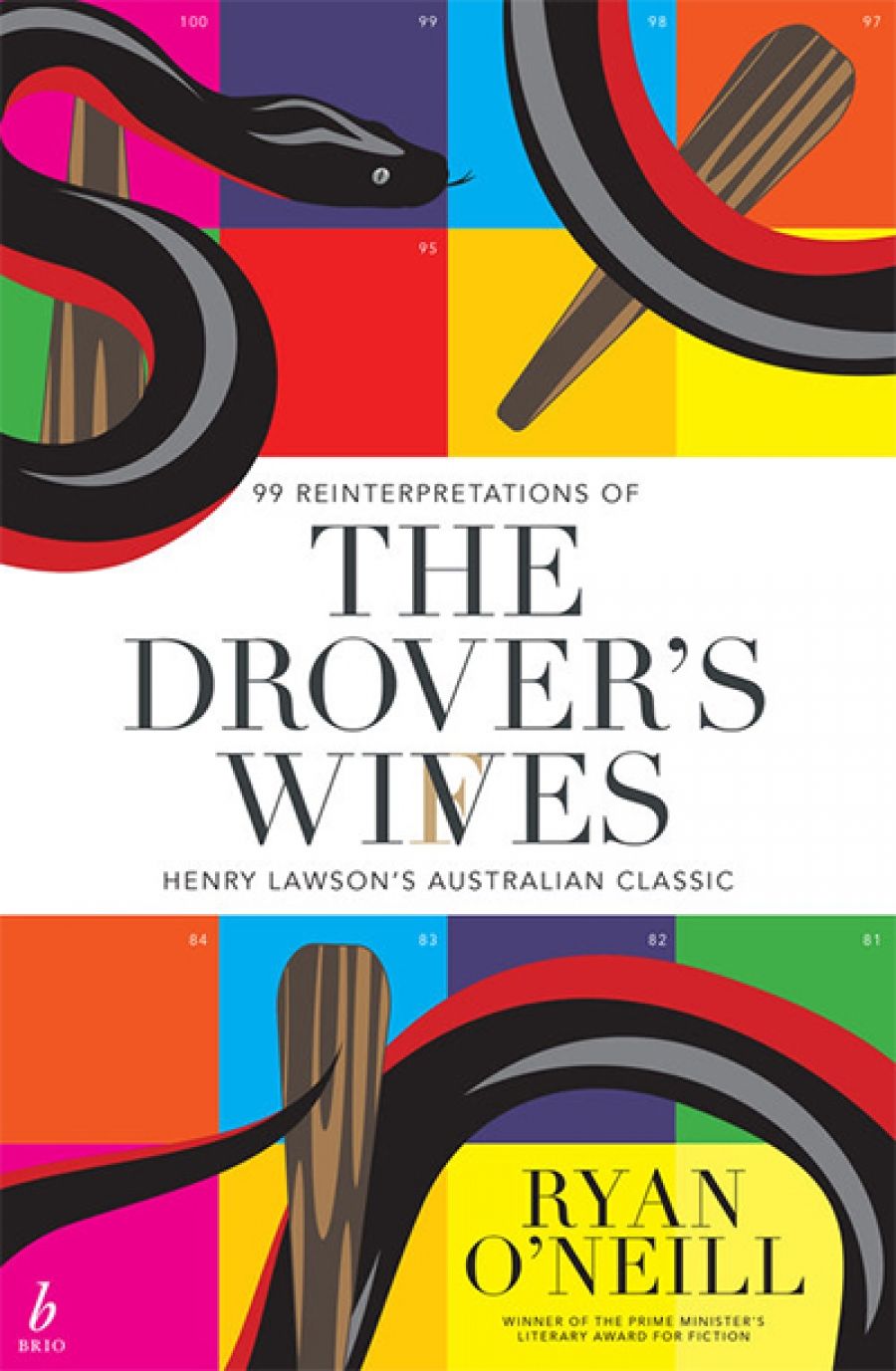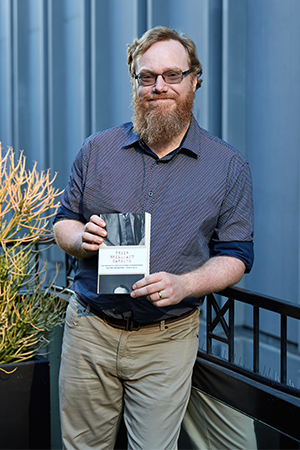
- Free Article: No
- Contents Category: Literary Studies
- Custom Article Title: Jen Webb reviews 'The Drover’s Wives: 99 reinterpretations of Henry Lawson’s Australian Classic' by Ryan O’Neill
- Custom Highlight Text:
‘The Drover’s Wife’ was one of the first stories I read when I arrived in Australia. I was living in the bush then, in hard beautiful country, and though my difficulties were First World Problems I shared the Wife’s nostalgia for nights in comfortable hotels, reliable transport, medical services. I did admire the story, though its ...
- Book 1 Title: The Drover’s Wives
- Book 1 Subtitle: 99 reinterpretations of Henry Lawson’s Australian Classic
- Book 1 Biblio: Brio, $26.99 pb, 256 pp, 9781925589290
There are many examples. 1945: Russell Drysdale paints her, an enigmatic woman standing four-square in an unsympathetic landscape. 1968: and the Australian Broadcasting Commission produces a feature adaptation. 1975: Murray Bail revisits the painting in a marvellously convoluted story. 1980: Frank Moorhouse adapts it as satire, and Barbara Jefferis casts a feminist eye on the story. A decade later, Damien Broderick focalises through Alligator the dog; and Kate Jennings publishes her novella Snake (1986), which is not Drover’s Wife but seems to channel it.
Then there was a break – a lacuna of two decades – after which Leah Purcell took on the story as theatre, tackling all its racism and its odd complexities (and winning Book of the Year in the 2017 NSW Premier’s Literary Awards). Meanwhile, the ACT government was producing its own version in the form of a new suburb, Lawson, which boasts a street called Drover Rise). Last year Frank Moorhouse launched his edited volume, The Drover’s Wife: A celebration of a great Australian love affair. And then we reach the most recent version: Ryan O’Neill’s The Drover’s Wives, ninety-nine versions of the story in ninety-nine modes, and most appropriately published by Brio Books. This collection exudes brio on every page, all enthusiastic vigour, often in high-parodic mode, sometimes as an in-joke for scholars of AustLit, occasionally with a tempering sadness but always with freshness and the capacity to surprise.
In this it is well aligned with the history of appropriation and adaptation of ‘The Drover’s Wife’; those works rarely offer an uninterrogated or admiring homage, but more often take a tongue-in-cheek attitude, a parody, a critique. O’Neill’s ninety-nine versions take this approach to another level. His collection is an experimental, impossible, keep-telling-the-joke-until-they-get-it challenge that pushes this cultural icon as far as it can go, stretching it into unlikely and unexpected shapes. It is a performative mode of writing, in which O’Neill shows a remarkable capacity to code-switch. Like the brilliant comic whose ruthless impersonations reduce her audience to helpless laughter, his many voices might be ruthless, but they are also convincing and compelling – and sometimes tender. He demonstrates a powerful grasp of the Australian vernacular in its many modes, including over-egged bogan, old-fashioned dinky-di, bush ballad. He weaves in elements that are expressly Australian, invoking the spirit of Baynton, invoking Julia Gillard’s misogyny speech, highlighting Lawson’s casual racism, poking fun at Quadrant.
But the book does more than mirror the local context, or play games: the multiple versions and the many prisms through which this little story is revisited gesture toward something I could almost call ‘universal’. O’Neill moves, apparently effortlessly, from Beckett to Hemingway to Joyce; through cryptic crossword, wordfinder, and script; gossip mag, self-help book, and social media squabble; poem and PowerPoint and anagram. And so on, ninety-nine times, mostly in words, sometimes in images and cartoons (and props to Sam Paine for the drawings).
 Ryan O'Neill (photograph by Peter Marko)This is an example of a fine satirist stretching his muscles. We already knew his capacity. Last year O’Neill’s Their Brilliant Careers: The fantastic lives of sixteen extraordinary Australian writers – another modular collection (or perhaps it is better classified as a discontinuous narrative à la Frank Moorhouse) – won the Prime Minister’s Literary Awards, and was shortlisted for the Miles Franklin and the NSW Premier’s Literary Awards. I read it primarily on public transport: that was a mistake, because I kept laughing out loud, attracting irritated or pitying looks from my fellow travellers. This new volume carries the same risks, for the same reason; it is captivating, coruscating, brilliantly honed satire. This is not something that is easy to produce: satire and comic writing do not have a central role in the literary world. ‘The novel’ tends rather to be resolutely serious; or at least, novels that win literary awards are serious, dramatic, tragic. Their Brilliant Careers shows that it is possible to convince judges otherwise; and The Drover’s Wives reinforces it: clearly, comic literature, when well done, can achieve the accolades more often reserved for Serious Literature.
Ryan O'Neill (photograph by Peter Marko)This is an example of a fine satirist stretching his muscles. We already knew his capacity. Last year O’Neill’s Their Brilliant Careers: The fantastic lives of sixteen extraordinary Australian writers – another modular collection (or perhaps it is better classified as a discontinuous narrative à la Frank Moorhouse) – won the Prime Minister’s Literary Awards, and was shortlisted for the Miles Franklin and the NSW Premier’s Literary Awards. I read it primarily on public transport: that was a mistake, because I kept laughing out loud, attracting irritated or pitying looks from my fellow travellers. This new volume carries the same risks, for the same reason; it is captivating, coruscating, brilliantly honed satire. This is not something that is easy to produce: satire and comic writing do not have a central role in the literary world. ‘The novel’ tends rather to be resolutely serious; or at least, novels that win literary awards are serious, dramatic, tragic. Their Brilliant Careers shows that it is possible to convince judges otherwise; and The Drover’s Wives reinforces it: clearly, comic literature, when well done, can achieve the accolades more often reserved for Serious Literature.
In fact, satire can double as Serious Literature. The Drover’s Wives is dedicated to Henry Lawson and Raymond Queneau: Lawson, depressed alcoholic poet of a bush he barely knew; Queneau, brilliant wit and cynic, founder of Oulipo. What a pair! And what a generous gesture to the antecedents of this book, writers who have in their own ways shaped the world of literature. With this new work, O’Neill brings something new and thoroughly engaging into the Australian literary scene, and makes the air and ear shimmer with his lyrebird capacity to reproduce the voices and genres and forms in which we humans tell our stories. Read it slowly, bit by bit, because satire gobbled too fast can overwhelm the reader or dull the senses. But read it, and odds are you will, by turns, laugh and weep.


Comments powered by CComment